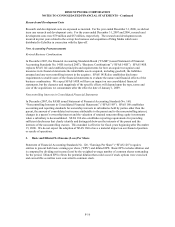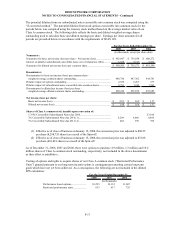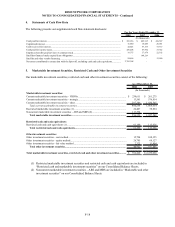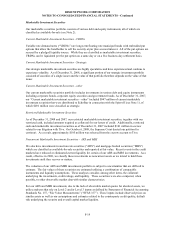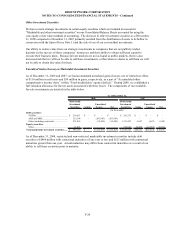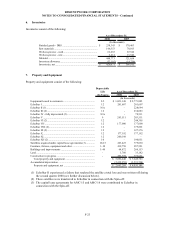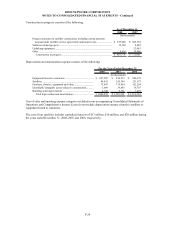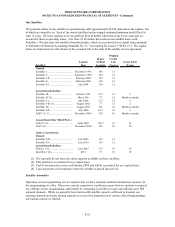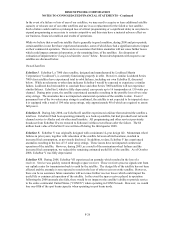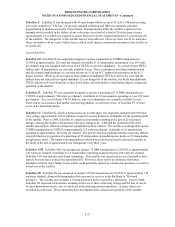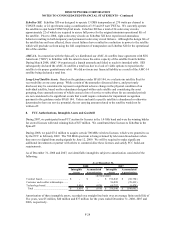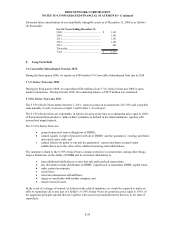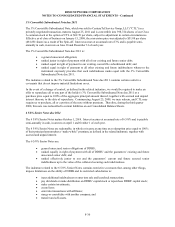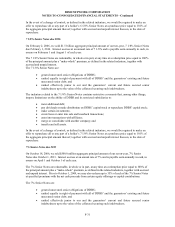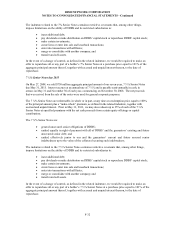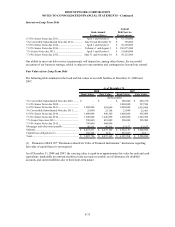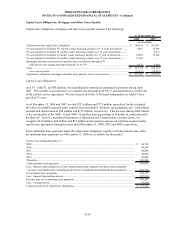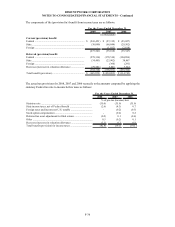Dish Network 2008 Annual Report Download - page 108
Download and view the complete annual report
Please find page 108 of the 2008 Dish Network annual report below. You can navigate through the pages in the report by either clicking on the pages listed below, or by using the keyword search tool below to find specific information within the annual report.
DISH NETWORK CORPORATION
NOTES TO CONSOLIDATED FINANCIAL STATEMENTS - Continued
F-26
In the event of a failure or loss of any of our satellites, we may need to acquire or lease additional satellite
capacity or relocate one of our other satellites and use it as a replacement for the failed or lost satellite.
Such a failure could result in a prolonged loss of critical programming or a significant delay in our plans to
expand programming as necessary to remain competitive and thus may have a material adverse effect on
our business, financial condition and results of operations.
While we believe that overall our satellite fleet is generally in good condition, during 2008 and prior periods,
certain satellites in our fleet have experienced anomalies, some of which have had a significant adverse impact
on their commercial operation. There can be no assurance that future anomalies will not cause further losses
which could impact commercial operation, or the remaining lives, of the satellites. See discussion of
evaluation of impairment in “Long-Lived Satellite Assets” below. Recent developments with respect to our
satellites are discussed below.
Owned Satellites
EchoStar I. EchoStar I, a 7000 class satellite, designed and manufactured by Lockheed Martin
Corporation (“Lockheed”), is currently functioning properly in orbit. However, similar Lockheed Series
7000 class satellites have experienced total in-orbit failures, including our own EchoStar II, discussed
below. While no telemetry or other data indicates EchoStar I would be expected to experience a similar
failure, Lockheed has been unable to conclude these and other Series 7000 satellites will not experience
similar failures. EchoStar I, which is fully depreciated, can operate up to 16 transponders at 130 watts per
channel. During prior years, the satellite experienced anomalies resulting in the possible loss of two solar
array strings. The anomalies have not impacted commercial operation of the satellite to date. Even if
permanent loss of the two solar array strings is confirmed, the satellite is not expected to be impacted since
it is equipped with a total of 104 solar array strings, only approximately 98 of which are required to assure
full power.
EchoStar II. During July 2008, our EchoStar II satellite experienced a failure that rendered the satellite a
total loss. EchoStar II had been operating primarily as a back-up satellite, but had provided local network
channel service to Alaska and six other small markets. All programming and other services previously
broadcast from EchoStar II were restored to Echostar I within several hours after the failure. The $6
million book value of EchoStar II was written-off during the third quarter 2008.
EchoStar V. EchoStar V was originally designed with a minimum 12-year design life. Momentum wheel
failures in prior years, together with relocation of the satellite between orbital locations, resulted in
increased fuel consumption, as previously disclosed. In addition, to date, EchoStar V has experienced
anomalies resulting in the loss of 13 solar array strings. These issues have not impacted commercial
operation of the satellite. However, during 2005, as a result of the momentum wheel failures and the
increased fuel consumption, we reduced the remaining estimated useful life of the satellite. As of October
2008, EchoStar V was fully depreciated.
EchoStar VII. During 2006, EchoStar VII experienced an anomaly which resulted in the loss of a
receiver. Service was quickly restored through a spare receiver. These receivers process signals sent from
our uplink center for transmission back to earth by the satellite. The design life of the satellite has not been
affected and the anomaly is not expected to result in the loss of other receivers on the satellite. However,
there can be no assurance future anomalies will not cause further receiver losses which could impact the
useful life or commercial operation of the satellite. In the event the spare receiver placed in operation
following the 2006 anomaly also fails, there would be no impact to the satellite’s ability to provide service
to the entire continental United States (“CONUS”) when operating in CONUS mode. However, we would
lose one-fifth of the spot beam capacity when operating in spot beam mode.


